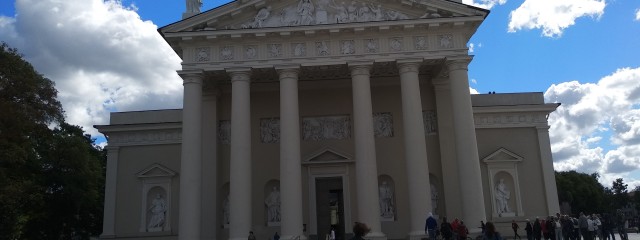Vilnius is the capital and city most populated in Lithuania. Located in the homonymous province, it has 554 060 inhabitants. It is a city that hides several peculiar places together with a large number of cultural and gastronomic treasures.
Its historic center or “old town”, one of the largest and best preserved medieval districts in Eastern Europe, was considered a World Heritage Site by Unesco in 1994.
The best way to get to know the city is through its museums, its monuments and history, among them the best to visit are:
Money Museum of the Bank of Lithuania
There are two tours in this museum that you can visit:
Tour ‘’100 stories about the Centenary of Lithuania’’
The tour is dedicated to commemorate the 100th anniversary of the restoration of the statehood of Lithuania. Tour participants will see the exhibition ‘’Fragments of the history of the Republic of Lithuania 1918–1940’’ and will get acquainted with the most significant moments in the history of Lithuania’s Centenary. They will also hear a lot of stories about the establishment of the Bank of Lithuania and the creation of national currency.
Tour ’’What does the Bank of Lithuania?
The tour deals with the following subjects in a playful and interactive way with the activities of the Bank of Lithuania, because of this they will realize the importance of this institution for Lithuania and will discover how the Bank of Lithuania can be useful. The issues to be addressed will be, How was the Bank of Lithuania established? Where did gold reserves accumulated in the interwar period disappear? What are the main functions of the Bank of Lithuania today? The past, the present and the future of the Bank of Lithuania.
Bell Tower of Vilnius Cathedral
The Bell Tower, one of the oldest and tallest towers of the Old Town, offers a beautiful panorama. Residents and guests of Vilnius will be able to see exposition of bells, the old clock of the city, explore the historic pictures of the reconstruction of Bell Tower and the Cathedral. The height of the Bell Tower is 52 m, with the cross – 57 meters.
Museum of the victims of genocide
It was then re-occupied by the Soviet Secret Police – the KGB – when the Nazis left in 1944. The KGB stayed until 1991 when Lithuania became independent from the Soviet Union.
The museum is divided into two parts – the upper two floors document the Lithuanian partisans’ resistance against the Soviet occupiers, the deportations of Lithuanians to Siberia and day-to-day life in the LTSR. The other part of the museum are the prison cells, and execution and torture chambers in the basement.
Its bloody history began when this former gymnasium became the headquarters of the Gestapo during the Nazi occupation of Lithuania in 1941.
It was then re-occupied by the Soviet Secret Police – the KGB – when the Nazis left in 1944. The KGB stayed until 1991 when Lithuania became independent from the Soviet Union.
Chillingly, the cells are exactly how the KGB officers left them upon leaving Lithuania in 1991.
National Museum of Lithuania
The National Museum of Lithuania is the largest depository of Lithuanian historical cultural heritage in the country. It is the oldest museum in Lithuania, dating back to 1855, when the Museum of Antiquities was established in Vilnius. Authentic exhibits help to recall the history of Lithuania and its national culture and customs.
Church Heritage Museum
Church Heritage Museum is based at St. Michael‘s Church in Vilnius old town. Church heritage forms a great and highly important part of the Lithuanian cultural heritage.
Church heritage (paintings, liturgical articles, historical documents and books) forms great and highly important part of the Lithuanian cultural heritage. Internal exposition of the church includes the most valuable exhibits of the museum that come form from the following houses of worship in Vilnius: the Cathedral, churches of St. Peter and Paul, St. Michael, St. Theresa. Heart of the exposition – monstrance and reliquaries from Vilnius Cathedral treasury – is a telltale witness of devotion tradition and goldsmith masterpieces. Glass display cases containing splendid examples of liturgical textile, other artistic church articles open new pages of a rich Lithuanian Church history and sacral art.
Lithuania Art Museum
Lithuanian Art Museum is a public institution granted the national museum status by the Government of Lithuania in 1997. Originally founded in 1933, the museum is one of the oldest and leading institutions of its kind in the country, the member of ICOM. It is distinguished for its rich Fine Arts collection that totals to about 230 thousand exhibit items which represent Old and Contemporary Master Paintings, Sculpture Prints and Drawings, Applied and Folk Art as well rare amber stone and jewellery specimens and other museum objects.
Tower of Gediminas
The Vilnius Castle Museum was opened in 1960, and in 1968 it became a subdivision of the Lithuanian National Museum. The exposition of the Vilnius Castle Museum displays reconstruction models of Vilnius castles of the second part of the 14th and the beginning of the 17th centuries, armament, iconographic material of old Vilnius. An observation deck on the top of the tower is the best place from which to appreciate a magnificent panorama of Vilnius.









